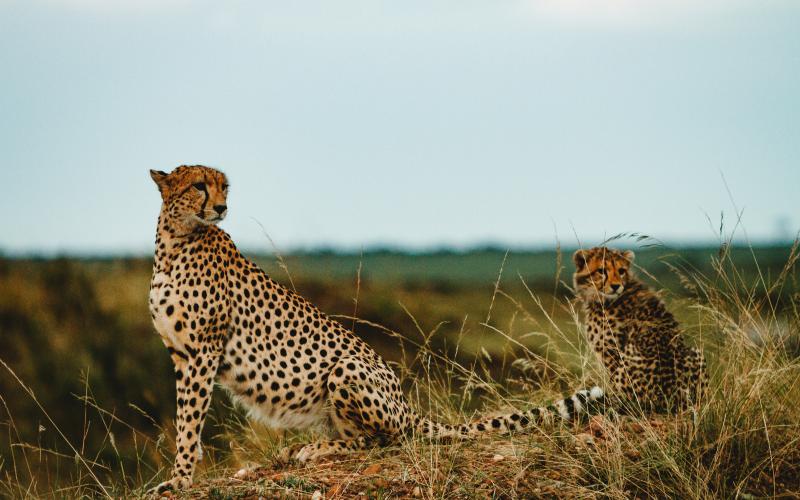Ecotourism is good for cheetahs? Not so fast.

Ecotourism is good for cheetahs? Not so fast.
Ecotourism in Kenya is celebrated as a win-win solution that benefits both cheetahs and humans. Tourists get to see cheetahs in their natural habitat while funding wildlife preserves. But what happens to cheetah cubs when they are surrounded by overeager visitors? A new study examines how ecotourism affects cheetah cubs’ chance at survival.
Broekhuis, Femke. 2018. “Natural and anthropogenic drivers of cub recruitment in a large carnivore.” Ecology and Evolution 8, no. 13 (July): 6748–6755. https://doi.org/10.1002/ece3.4180.
Each year, many adventurous travelers make the journey to nature parks like the Maasai Mara National Reserve in Kenya, hoping to encounter wildlife up close. Nothing could be more exciting than spotting a cheetah, the world’s fastest land animal. However, these tourists may not realize that cheetahs are in danger of extinction. Ecotourism safaris raise money to protect the cheetah and give visitors the opportunity to view the charismatic cat, which seems like a win-win for both groups. But how much do we know about the effect this has on the cheetahs? Could running into humans prevent cheetahs from outrunning extinction?
A recent study published in the journal Ecology and Evolution investigates how the number of human visitors affects cheetah cub survival in wildlife preserves in Kenya’s Maasai Mara region. Led by Dr. Femke Broekhuis, a team of researchers from the Kenya Wildlife Trust and the University of Oxford Wildlife Conservation Research Unit track cheetah cub recruitment, or the survival of cheetah cubs to adulthood, over the course of four years. They hypothesize that the number of tourists does not affect cheetah cub recruitment. Instead, the team predicts that the abundance of other predators and lower vegetation density, or plant cover, negatively affects cub recruitment.
To the author’s surprise, the study found that the growing number of tourists have a negative impact on cheetah cub recruitment. In the wildlife preserves, when a mother cheetah is located with her adorable cubs, tourists’ Jeeps quickly approach. One day, researchers even observed 64 vehicles surrounding a mother and her litter. Overwhelmed, and sometimes even physically blocked from escaping, the mother cheetah cannot hunt for prey or provide food for her offspring. Cheetah cubs suffer the consequences. The study found a significant reduction in the number of cheetahs that make it to adulthood in areas with high tourist activity.
Consistent with the study’s hypotheses, cheetah cubs’ survival also depends on how much plant cover was present. Researchers found that denser vegetation leads to higher cub recruitment. However, contrary to what the researchers predicted, the abundance of predators such as lions and spotted hyenas - which are known to prey upon cheetah cubs - doesn’t affect the cubs’ survival to adulthood. It is possible that vegetation plays an important role, although further study is needed to confirm this. . Areas with higher plant cover provide the cubs shelter and protection from predators, giving them a space to hide until the coast is clear. Ultimately, it was interactions with humans rather than other predators that affected cub survival.
How can we use ecotourism to save cheetahs without harming them?
Dr. Broekhuis recommends a few ground rules to prevent cheetahs from experiencing a Jeep overload. She suggests prohibiting tourist vehicles from operating within 30 meters of a cheetah. Additionally, staff could restrict vehicles from entering certain sections of wildlife preserves. The study also suggests that wildlife preserves should encompass both open savannah areas and densely vegetated areas to provide cheetahs with both open hunting grounds and covered places to hide. Ideally, ecotourism ventures throughout the continent could implement these ideas to protect other large wildlife species on the savannah from similarly stressful situations.
A significant challenge facing ecotourism is finding the balance between humans’ desire to get close to animals and the animals’ need for protection. In Kenya’s Maasai Mara region, researchers found that putting a few rules in place could protect cheetah cubs as well as other wildlife species. Governments, conservation organizations, and ecotourism companies can act now to help ensure that future generations can still be able to spot a cheetah on the savannah.




